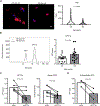Metabolic reprogramming in memory CD4 T cell responses of old adults
- PMID: 31279855
- PMCID: PMC6827883
- DOI: 10.1016/j.clim.2019.07.003
Metabolic reprogramming in memory CD4 T cell responses of old adults
Abstract
To determine whether aging affects the ability of T cells to undergo metabolic reprogramming upon activation, we compared CD4 T cell responses after polyclonal in vitro stimulation. Compared to younger adults, CD4 memory T cells from healthy older individuals exhibited a higher upregulation of oxidative phosphorylation with increased production of reactive oxygen species and intracellular and secreted ATP. Increased ATP secretion led to increased purinergic signaling and P2X7-dependent increases in cytoplasmic calcium. The increased mitochondrial activity was not due to a difference in activation-induced mitochondrial biogenesis. Expression of carnitine palmitoyl transferase 1 was higher, conversely that of fatty acid synthase was reduced in older T cells, resulting in increased fatty acid oxidation, while depleting intracellular lipid stores. The aged CD4 memory T cells therefore maintain a more catabolic state in lipid metabolism, while their ability to upregulate glycolysis upon activation is preserved.
Keywords: Aging; CD4 memory T cells; Fatty acid oxidation; Immunometabolism; Immunosenescence; T cell activation.
Published by Elsevier Inc.
Conflict of interest statement
The authors have declared that no conflict of interest exists.
Figures





References
-
- Nikolich-Žugich J The twilight of immunity: emerging concepts in aging of the immune system. Nat. Immunol. 2018;19(1):10–19. - PubMed
Publication types
MeSH terms
Substances
Grants and funding
LinkOut - more resources
Full Text Sources
Research Materials

